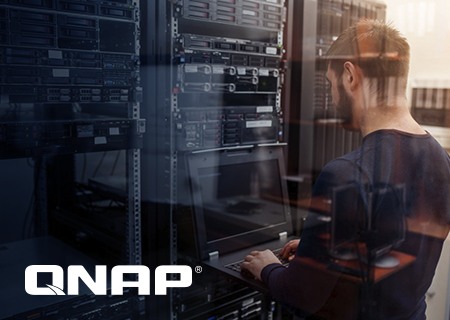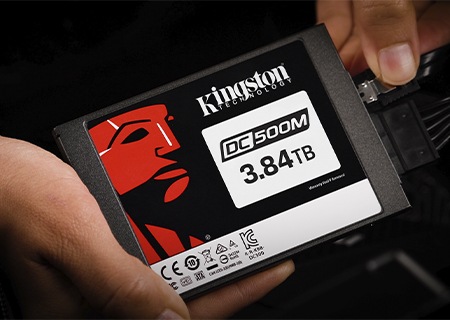As recording formats become more sophisticated and offer more high-resolution and storage options, content creators need more and better storage options to cope with the rigors of uploading, downloading, and editing such large video files. But how to optimize storage in this creative world?
Why use a NAS for content creation?
Content creation, especially producing long-form videos, requires a significant amount of data storage. This data is valuable and must not only be stored but also backed up on a reliable system.
Accounts are always at risk of hacking, and many creators are at risk of having their accounts disabled or permanently deleted. In either case, an unprepared creator can lose access to the files on which they built their brand: files without which it can be much more difficult, if not impossible, to continue their business.
Rather than risk professional and financial ruin, many creators of all sizes are opting for network-attached storage (NAS) devices to organize and back up the gigabytes of data that make up their content.
There are many reasons for this. NAS systems give creators flexible storage capabilities that can be expanded as their data volume grows, and RAID (redundant array of independent drives) configurations will protect their valuable data in the event of drive failure.
With 4k and 8k images becoming more common, high-speed connections such as Thunderbolt, 2.5, and especially 10 GbE, are required to reduce the time it takes to transfer files to and from storage.
The instant backups that NAS systems simplify are essential to guard against accidental deletions. Backups also provide some degree of protection against ransomware attacks. Some NAS systems integrate seamlessly with non-linear editing tools such as iMovie or Final Cut Pro X. QNAP is one of the leading NAS system providers.
Before choosing a NAS, content creators should consider the following:
- The number of video editors and workstations that will work on the data in parallel.
- PC or Mac? Mac users should make sure they have Thunderbolt slots on their NAS.
- The expected capacity of the NAS, as well as its lifespan.
- The speed required for the connection. Is a 10GbE connection necessary or will a 2.5GbE or 1GbE connection be enough?
Usage scenarios
The different usage scenarios depend on the type of content creator. For example, the setup of a sole content creator will be very different from that of a production studio.
Creator alone:

- A single person responsible for uploading and editing content
- Using a single PC/Mac
- Generally transfer short videos in full HD/1080p resolution (5 to 15 GB)
In these circumstances, 20 to 30 GB of NAS may be sufficient, depending on the amount of content to be created. Here are some examples of products this type of designer could use:
- TS-x53D for PC users (where x represents the number of bays; we recommend between 4 and 6 bays and avoid 2)
- TS-x53-b-t3 with Thunderbolt 3.0 for Mac users
This configuration would include 4 or 6 bays, a mid-sized processor (such as Intel Celeron), 2 2.5 Gigabit ports, and a standalone chassis that can fit under a desk. All QNAP NAS can accommodate hard drives or SSDs, but a normal hard drive is recommended for creators of this type as it remains the most cost-effective solution for high storage capacity today.
Small studio:
- Up to 5 workstations and video editors working on the data.
- Workers can use Macs or PCs.
- Videos can have a quality of up to 4k.
- Since multiple mounters use the files, a 2.5 GbE connection is possible. However, a 10 GbE connection is recommended.
In such situations, for example a marketing agency producing television advertising content, or a music video production company, more robust storage capacity and high-speed editing are required.
Such an agency will use a combination of SSDs and hard drives, or exclusively SSDs. In use cases such as these, multiple workstations will be connected to a single NAS in the office. Workers collaborate on the NAS using it as a platform.
Everyone will have their own tasks to accomplish. One corrects colors and erases unwanted objects. Another adds music. Another assembles the desired clips. And finally, a last one modifies backgrounds or composes graphics.
Hundreds of 1-5 minute clips will be produced over the life of the NAS. Once the project is complete, the NAS saves the final content over a 10 GbE connection to a larger server.
To this end, smaller studios can use products such as the TS-x73A and TVS-x72XT. Both come with decent CPU power for your usage scenario. The TS-x73A offers two 2.5 GbE ports, while the TVS-x72XT has 10 GbE ports, two 1 GbE ports, and two Thunderbolt 3 ports. There is up to 64 GB of RAM available, and Products can be configured with 4, 6 and 8 bays. Depending on the drives you use, you can reach over 100TB of storage.
Large studio:
- Many video editors working on data on various workstations.
- Workers can use Macs or PCs.
- Videos can have a quality of up to 4k.
- Since multiple editors are processing the files, a 10 Gigabit connection is recommended.

For a growing video production company, which until now has used multiple portable hard drives, the fact that only one user at a time can access a given storage device is a problem. Also, the need to have an organized and centralized storage solution, capable of providing simultaneous access to multiple PCs or Macs, is a strong motivation to upgrade to NAS systems.
This solution allows you to make video edits without having to move the files to the workstation. This also means that the process of archiving projects is simplified. NAS systems can potentially be more cost-effective than other solutions, which is of particular interest to small and growing businesses.
Many major studios use QNAP’s TVS-h1688X. It features a total of 16 bays, an Intel® Xeon® NAS with four 2.5-inch and twelve 3.5-inch trays, two 10 GbE network ports and four 2.5 GbE network ports.
The NAS can be configured in a RAID 6 format to achieve high read and write speeds while meeting capacity and data protection requirements. The high speed offered allows simultaneous editing of videos stored on the NAS.
As TVS-h1688X supports both SSDs and HDDs, some users may have the idea to use SSDs as cache, for example 4 SSDs and 12 HDDs in a 16-bay model. For this model, we recommend 8 SATA SSDs in RAID 5, associated with 8 hard drives.
SSD caches do not provide speed benefits when it comes to sequential read/write. In video editing scenarios, data works differently than in databases with many small files. Video files are large and must be played in a certain order.
For content creators, we recommend using one SSD storage pool for high-speed editing and sharing data, and using the second HDD storage pool to store the final product. Of course, this system makes data transfer services such as WeTransfer obsolete.
What storage solution should you consider as a content creator?
Once a creator has chosen their NAS model and determined how many bays they need, the next question is what to fill those bays with.
There are many storage media options available in the market. Also, it can be difficult to choose the optimal support for your particular situation.
Hard drives have dominated the market for 30 years and maintain their great popularity thanks to the current SATA interface that they use and which is implemented on a wide range of systems, from desktop PCs to laptops to laptops. servers and NAS.

In terms of price per gigabyte, hard drives remain the best choice. However, SSD adoption rates have increased in recent years.
The NAND Flash technology of SSDs offers exceptional performance compared to the mechanical spinning platter technology of hard drives.
NAND Flash technology continues to evolve, and SSD manufacturers such as Kingston have introduced competitive new products, including SSDs with higher storage capacities.
Increasingly, SSDs are competing with hard drives on price. What’s more, the introduction of SATA-based SSDs only further illustrates the extent to which SSDs outperform hard drives:
550 MB/s versus 120 MB/s. Even with the limitations of the SATA bus, it is common to see SATA-based SSDs outperform older hard drives by 10 to 15 times when looking at overall system performance.
In addition to performance, another thing to consider when choosing an SSD is endurance. SSDs have a limited lifespan due to the nature of NAND Flash technology. Enterprise-class SSDs generally offer higher endurance than client SSDs, which is why we recommend opting for enterprise-class SSDs such as the Kingston DC Series SSD as your storage solution for NAS systems.
This increased functionality heralds the “massive potential” of NVMe storage devices, thanks to increased efficiency, performance and interoperability across a wide range of systems. Experts agree that this technology will become the new industrial standard.
The different formats of SSDs must also be taken into account. 2.5″ drives are the most common, but smaller formats such as M.2 are becoming more popular.
The latest NAS models tend to have at least one socket for M.2 SSDs, which means users can insert 3.5″ or 2.5″ hard drives into the front bays to maximize storage capacity, while installing M.2 SSDs to improve NAS performance.
If you have any questions about which SSDs or even HDDs might be a good choice for a particular NAS, Kingston offers Ask an Expert service which includes technical support to assist you with all kinds of SSD and HDD decisions. HDDs .
We will be happy to help you, even with questions that do not directly concern our products. And QNAP offers resources for aspiring NAS system owners, like its compatibility list for finding compatible drives, its guide on how to choose and upgrade the ideal NAS , and its product selector . Contact QNAP sales for more information.
When looking to optimize and increase your overall production, choosing the right technology partners is essential.
Ultimately, a partner who is more interested in upselling and meeting quotas than helping your business find the solution that will allow it to grow incrementally will not meet your needs.
Kingston supports you no matter the size of your purchase, as does QNAP, which is committed to providing superior customer service to all its customers, large and small.



